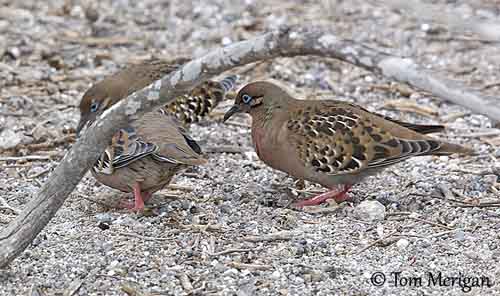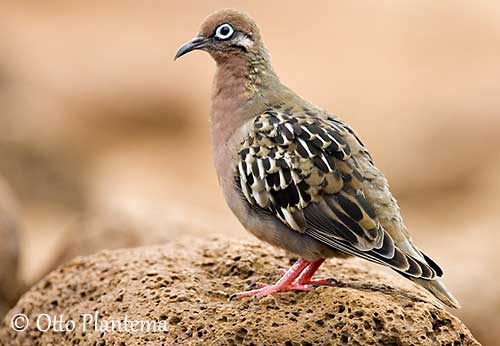
Fr: Tourterelle des Galápagos
All: Galapagostaube
Esp: Zenaida de Galápagos
Ita: Tortora delle Galapagos
Nd: Galápagostreurduif
Sd: Galapagosduva
Photographers:
John Anderson
John Anderson Photo Galleries
Tom Merigan
Tom Merigan’s Photo Galleries
Otto Plantema
Trips around the world
Text by Nicole Bouglouan
Sources:
HANDBOOK OF THE BIRDS OF THE WORLD vol 4 by Josep del Hoyo-Andrew Elliott-Jordi Sargatal - Lynx Edicions - ISBN: 8487334229
PIGEONS AND DOVES by David Gibbs, Eustace Barnes and John Cox - Pica Press Sussex - ISBN: 1873403607
BirdLife International (BirdLife International)
Galapagos Dove
Zenaida galapagoensis
Comumbiformes Order – Columbidae Family
INTRODUCTION:
The Galapagos Dove is endemic to the islands. It is usually seen in the driest parts of the main island. This Columbidae has adapted to the Galapagos. Its slightly down-curved bill allows the bird to feed on seeds from Opuntia helleri, by picking them from the ground. In the same way, the long, strong legs are well-adapted to a more terrestrial life among the volcanic rocks of these islands.
DESCRIPTION OF THE BIRD:
Biometrics:
Length: 18-23 cm
Weight: 88 g
The adult male has dark brown upperparts with slight vinous gloss on upper mantle and hindneck. The wings have spotted and streaked appearance due to feather’s pattern with black border and white median streak. On the folded wings, we can see a white patch formed by the white outer webs of distal coverts. The primaries are black with narrow white edges on outer webs.
The tail shows dark brown central rectrices and grey outer ones. We can see a black subterminal bar and a narrow, grey terminal band.
On the underparts, the breast is pinkish-brown, turning buffish on the belly. The underwing is dark bluish-grey. The undertail-coverts are pale grey.
Head and neck are reddish-brown. The conspicuous eyering is cobalt-blue, surrounded by black border. There are two parallel black stripes across each side of the face, separated by a greyish stripe from the gape to the nape.
The bill is black, fairly long and slightly downcurved. The eyes are dark brown. Legs and feet are purplish-red.
The female is similar but duller, mostly fawn-brown below, with reduced iridescence on neck. She is smaller than male.
The juvenile resembles adults but it is duller.

SUBSPECIES AND RANGE:
There are two subspecies.
Z.g. exsul occurs on Culpepper (Darwin) and Wenman (Wolf) in N Galapagos. This race is larger and darker than nominate.
Z.g. galapagoensis (here described) is found on the mayor islands of Galapagos except both previous.
HABITAT:
The Galapagos Dove is found in both arid and semi-arid areas with various open habitats including rocks, grass and scrub, in dry rocky lowlands with scattered trees and Opuntia helleri. This species has adapted to habitat modification due to firewood and grazing.
CALLS AND SONGS:
The Galapagos Dove gives very soft growl or coo “bororororororrr” or “wuk…r-r-r-r-r-r-ruu” repeated at 8-10 second intervals. It also produces soft, deep “bob-bob-bob-rurururr-bububurr”. These sounds are very low and usually inaudible at any distance.
BEHAVIOUR IN THE WILD:
The Galapagos Dove forages on the ground among the leaf litter and undergrowth. It scratches and digs in the soil with the bill with peculiar movements. From an observation, this dove may remove its own volume of soil within five minutes! It also takes the too hard seeds, abandoned by the Darwin’s Finches.
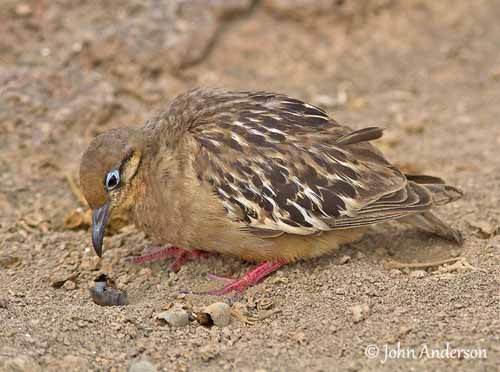
The diet varies seasonally. Caterpillars and Opuntia helleri blossoms are taken during the wet season. During the drier periods, it feeds mainly on the ground where it can find buried seeds from various plant species.
It may sometimes feed on cactus pulp, fly larvae and grubs, found in Opuntia trunks where the softened spines (due to another adaptation of the plant) allow the bird to perch.
The feeding behaviour may also differ according to the food resources of each island.
The breeding season is variable throughout the archipelago, although the birds are active from January to November. These variations are closely related to food resources.
The displays are fairly similar to those of other Columbidae, with the male calling from low perch or from the ground during the day. The displays include bowing in front of the female with horizontal body. The head is lowered and the wings are dropped and quivering, whereas the slightly fanned tail is raised to expose the pattern. The neck is also inflated while it is calling.
The copulation occurs after these displays. Usually, the male runs around her and feeds her before mating.
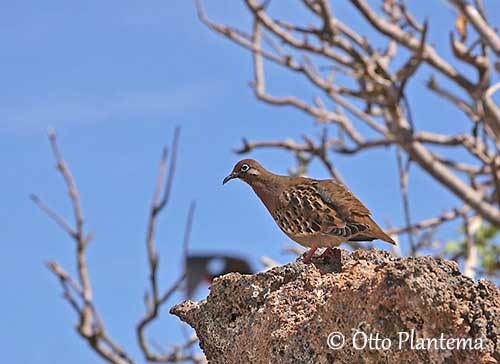
The Galapagos Dove is often seen alone, in pairs or in small groups. It is resident in its range, with only some movements between islands.
This dove is commonly seen on the ground. It is reluctant to take-off when disturbed, and only flies over very short distances. The flight is fast and direct, with rapid wingbeats.
REPRODUCTION OF THIS SPECIES:
The breeding season varies between islands, but usually occurs between January and November, mainly from March to June, with peaks in March and April.
Like most Columbidae, the Galapagos Dove builds a loose structure with twigs and sometimes lined with rootlets or grasses. It can be placed on the ground, in crevice or hollow, in rock cavity, or even in old nest of Galapagos Mockingbird, about 75 centimetres above the ground.
The female lays two white eggs. The incubation shared by both parents lasts 13 days. The young birds fledge about 13-17 days after hatching. As soon as they are independent, the adults re-nest. They can produce up to three clutches per season.
The parents may perform distraction displays to take predators away from the nest-site.
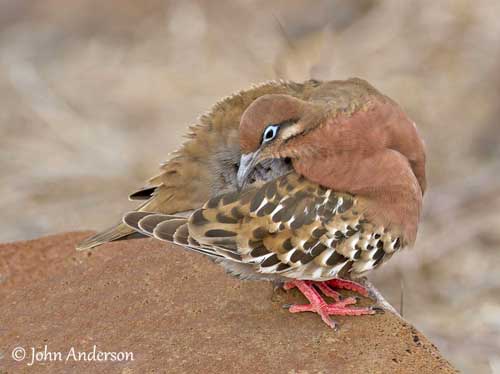
PROTECTION / THREATS / STATUS:
The Galapagos Dove appears to have relatively secure populations. However, this species is threatened by introduced predators, human developments and diseases from introduced domestic pigeons. Tourism increasing, urbanisation and growth of human population involve degradation of the habitat and pollution. Fortunately, the hunting pressure has decreased.
Currently, this species is not globally threatened and evaluated as Least Concern.
